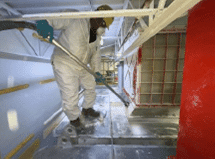Combustible dust can present a serious hazard to your industrial facility, potentially sparking a flash fire or explosion. Here, we will explore the dangers of combustible dust, common examples of combustible dust sources, and how your manufacturing or processing facility can minimize the risks associated with combustible dust through proper removal and cleaning.
The Hidden Danger: Understanding Combustible Dust in Industrial Facilities
Understanding combustible dust is the first step to mitigating the dangers these materials pose to your facility and personnel.
What Is Combustible Dust?
According to NFPA guidelines, combustible dust is finely divided, solid combustible particulates that present an explosion or flash-fire hazard when the particles are suspended in the air or a process-specific oxidizing medium over a certain concentration range.
Why Is It a Hazard?
According to a report by Dust Safety Science, a combustible hazard research organization, 51 dust fires occurred in the U.S. in just the first half of 2021, causing 5 injuries. Throughout the rest of the world, during the same period, 28 dust explosions occurred, resulting in 39 injuries and 8 deaths. A notable combustible dust explosion that saw media coverage in the U.S. was a sugar dust explosion that occurred in Georgia in 2008. The incident resulted in 40 injuries and 14 fatalities.
These incidents and statistics demonstrate the increasing risk of dust explosions in industrial workplaces. Industrial facilities must prioritize the safety of employees by proactively addressing combustible dust risks and preventing incidents leading to injury, fatality, and property damage.
Common Culprits: Examples of Combustible Dust in Different Industries
Industrial facilities and workplaces rely on numerous materials for daily operations, including components that present a combustible dust hazard. Some examples of these materials include:
- Rice, flour, corn starch, powdered milk, sugar, and other fine or powdered products present a risk to agricultural and food processing facilities.
- Sulfur, coal, and chemical dust are a risk to the pharmaceutical industry.
- Synthetic fibers, wool, silk, and other textile products present a risk of explosion without routine monitoring in the fabric manufacturing industry.
- Wood materials in storage for manufacturing new products can create combustible dust in any facility that uses them.
- Magnesium, bronze, aluminum, and other metals pose a combustible dust risk to metal manufacturers and processors.
Mitigating the Threat: Strategies for Preventing Combustible Dust Explosions
When combustible dust is not properly contained or prevented, it can be detrimental not only to your facility’s appearance but also to its safety. Investing in a routine combustible dust cleaning program enhances the appearance of your facility while preventing hazardous dust accumulation.
At Interior Maintenance Company (IMC), our experts will meet your unique high surface and combustible dust cleaning needs. With our specialized equipment and skilled technicians, we can clean hard-to-reach places to eliminate combustible dust accumulation throughout your facility. Our team can clean any space that meets our minimum requirement of at least 10,000 square feet.
Combustible dust removal requires delicate handling, so IMC uses the most effective and safest equipment available to complete our tasks. We rely on explosive-proof vacuum equipment with HEPA filtration to safely remove harmful dust and debris from high surfaces. To reach these surfaces, our crew is equipped with OSHA-compliant lifts, scaffolding, and ladders.
Combustible dust removal is sometimes called explosive dust mitigation, dust suppression cleaning, fire prevention cleaning, dust explosion prevention cleaning, hazardous dust removal, and industrial dust cleaning. No matter what your facility management prefers to call it, IMC can handle all your combustible dust removal needs. As a leader in high surface cleaning, IMC can clean exposed rafters, ductwork, conduits, and piping.
Several of the common industries we serve that require regular combustible dust removal include:
- Food processing
- Chemical processing
- Agriculture
- 3D printing or additive manufacturing
- Fossil fuel power generation
- Recycling facilities
- Metal processing
- Rubber and tire manufacturing
- Pharmaceutical
- Textile and furniture manufacturing
- Pulp and paper processing
- Plastics manufacturing
Combustible Dust Removal From IMC
Combustible dust can come from various sources and present a hazard if not properly removed. IMC offers extensive industrial and commercial cleaning services and has over 50 years of experience in the industry. Our experts use extensive industry knowledge, experience, and OSHA-certified equipment to safely remove combustible dust from even the hardest-to-reach places in your industrial facility. Contact us to connect with a specialist about your dust removal needs.


